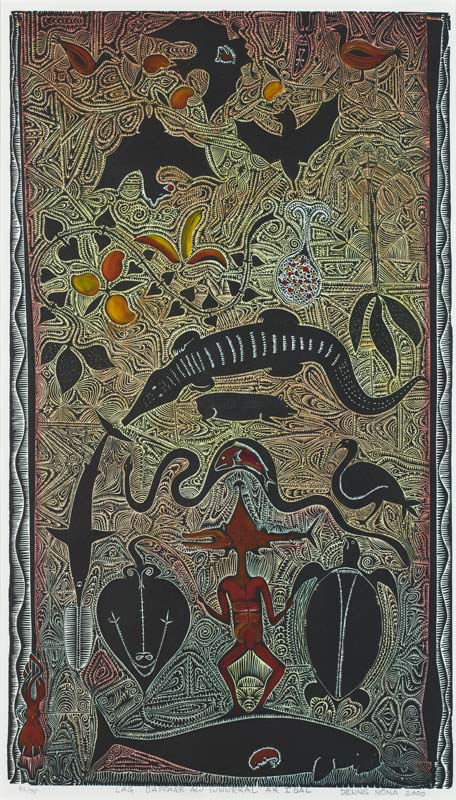We acknowledge the Traditional Owners of the land on which the Queensland Art Gallery | Gallery of Modern Art stands and recognise the creative contribution First Australians make to the art and culture of this country.

Dennis Nona / Kala Lagaw Ya people / Australia b.1973 / Malu lag a dapar – A urungu aidal (Sea, land and air creatures) 2000 / Linocut, hand-coloured on BFK Rives paper, ed.42/75, second state / 87 x 50cm / Purchased 2002 through the Queensland Art Gallery Foundation / Collection: Queensland Art Gallery | Gallery of Modern Art / © Dennis Nona
Dennis NonaMalu lag a dapar – A urungu aidal (Sea, land and air creatures) 2000
Not Currently on Display
The story of Malu lag a dapar – A urungu aidal is described in the catalogue for the exhibition ‘Gelam Nguzu Kazi – Dugong My Son’:
‘This print shows the interconnectedness of the different creatures of the sea, land and air that inhabit the Torres Strait Islands. The man standing at the bottom centre of the print is holding the tail of the stingray and the flipper of the turtle to represent how connected and dependant (sic) humans are on the animal world. He is wearing a crocodile and shark mask which is used in funeral ceremonies on Western islands. He is standing on a pregnant dugong which is very fat and highly prized. The geese portrayed come to the islands during migration each December and are the most favoured eating birds of the area. The snake (Tabu), is the artist’s father’s totem. The sword shark, octopus, crocodile, pig, dugong, turtle, stingray and bat are all important totems of the different villages throughout the islands.
The centre section represents the coastal area where pigs roam the mud flats and are often taken by crocodiles as a delicacy. Above the crocodile, the wild bush vegetables depicted: sweet potato, mango, banana, wild berries and cassava are are all important in the diet of the islanders, providing them with protein and energy. At the top of the print is the canopy of trees where flying foxes and Seserre birds, similar to willy-wagtails, are eating mangoes and mangrove fruits.
Shown on either side of the print is the harpoon used for spearing turtles and dugongs. The bamboo spear is used to catch octopus and fish. The patterns in the background represent marine life and the teeth of the crocodile and shark.’1
Endnotes:
1. Cecilia Alfonso and Michael Kershaw (eds), Gelam Nguzu Kazi – Dugong My Son, Kubin Community Council, Mua Island, 2001, p.26.
Dennis Nona was born in 1973 on Badu Island in the Torres Strait. As a young boy Nona was taught the Badu Island traditional craft of woodcarving. Nona’s practice is primarily based on the rich narrative legends of the Torres Strait Islander people.
The symbols that Nona uses – sea creatures, masks and designs – are also influenced by the art of coastal Papua, and can be found on carved drums and similar trading items. The mythical figures in Nona’s prints are based on a dream vision of his traditional culture, which he experienced in 1993, his final year at Cairns TAFE. Although these images are used by traditional carvers and are not to be viewed by outsiders, the authority of Nona’s vision has made him comfortable in revealing them to the broader public. Subsequently, his elders have given Nona permission to use images from these stories in his linocuts.
Nona’s dream visions of his traditional culture have continued. He has refined the style that he established in Canberra, and his designs have become sharper and more intricate. He feels strongly about retaining his traditional culture and hopes to pass on this heritage through his art practice.